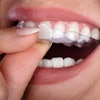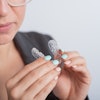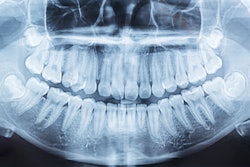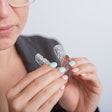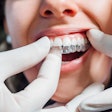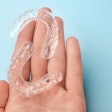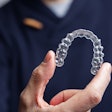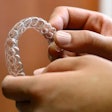
Patients with fixed appliances (FAs) and clear aligners (CAs) experience comparable pain levels and intensities two days after receiving appliances, according to a study recently published in the American Journal of Orthodontics and Dentofacial Orthopedics.
Furthermore, FA pain intensity peaks at two days before decreasing by seven days. CA pain, by contrast, follows a similar pattern initially but remains minimal afterward, the study's authors wrote.
"Both the FA and CA groups experienced similar rates and intensities of pain 2 days after the delivery of appliances at the first appointment," wrote the authors, led by Dr. Victor Chan of the Virginia Commonwealth University Department of Orthodontics (Am J Orthod Dentofacial Orthop, July 30, 2024).
For the study, digital surveys were collected from 87 adult patients age 18 and older treated with CA or FA at two Virginia orthodontic offices. The seven-item survey was administered at three time points for each appointment: preappointment, two days postappointment, and seven days postappointment.
Subjects were surveyed for the first six months of treatment. CA attachments or FA brackets and bands were bonded at the initial appointment. FA adjustments occurred every four to eight weeks (typically involving a switch to larger-dimension archwires), while CA adjustments were every two to three months (delivering new aligners). CA patients changed aligner trays every seven days and wore them 22 hours a day, they wrote.
For the two days postappointment time point, both groups experienced high rates of pain (FA: 75%, CA: 78%). The FA group had significantly higher pain rates after the second (61% vs. 21%, p = 0.006), third (83% vs. 27%, p = 0.001), and fifth appointments (80% vs. 18%, p = 0.009), the team reported. Seven days postappointment, the FA group also reported significantly higher pain rates than the CA group after the first (62% vs. 24%, p = 0.020) and fifth appointments (62% vs. 17%; p = 0.041).
Both groups reported dull pain, but 31% of the FA group reported throbbing pain, and 20% reported sharp pain at two days postappointment (p = 0.035). The CA group reported the most pain at rest, while the FA group found chewing the most painful (p = 0.002). The FA group also had a higher rate of analgesic consumption after the first appointment (p = 0.037), according to the study's authors.
There were some limitations of the study. Future studies should explore adjustments more precisely by establishing a standardized treatment progression for both FA and CA patients, the authors wrote.
"After the first 2 days of treatment, both FAs and CAs produce a similar rate of pain and pain intensity, but after that, CA treatment has a lower rate and intensity of pain," Chan and colleagues wrote.

